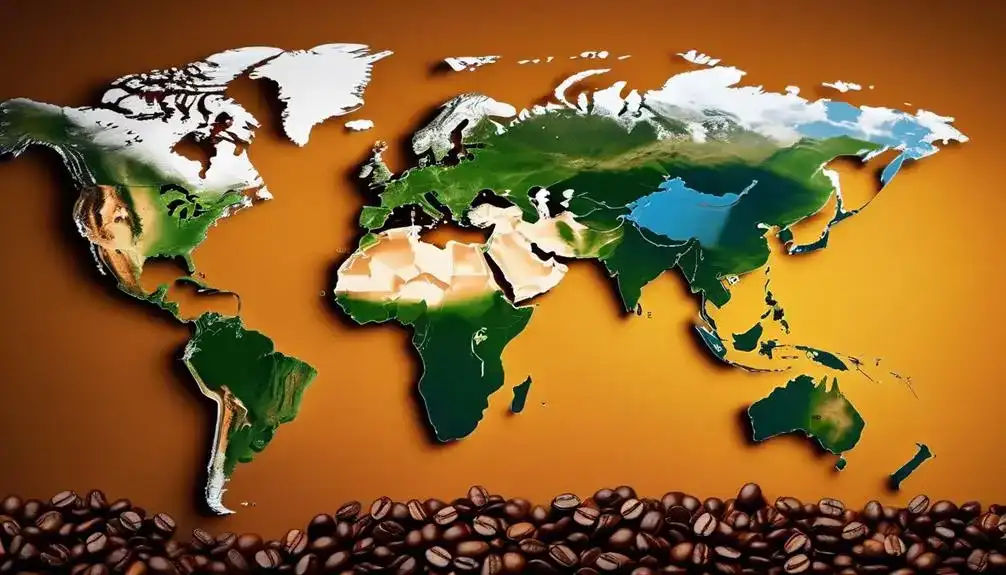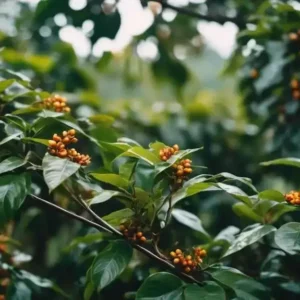Have you ever pondered whether the taste of excelsa differs in your country?
From the lush landscapes of Laos to the sun-drenched fields of Ethiopia, the flavor profiles of excelsa coffee can vary significantly from one region to another.
But why does this occur? The answer lies in a combination of factors, including soil composition, climate conditions, and cultivation methods.
Understanding these elements can shed light on the intriguing variations in excelsa's taste that you may have noticed.
Regional Variations in Excelsa Flavor

In different regions, the flavor of Excelsa coffee varies subtly, adding to its allure for coffee enthusiasts. The soil composition plays a significant role in shaping the unique taste of Excelsa beans. For instance, in the mountainous regions where the soil is rich in minerals, the coffee tends to have a complex and robust flavor with hints of earthiness. Conversely, in areas with sandy soils, the coffee may exhibit a lighter body with fruity and floral notes. This diversity in flavor profile based on soil composition offers an exciting prospect for coffee aficionados seeking novelty and innovation in their brews.
Moreover, the roasting techniques employed in different regions further contribute to the distinct flavors of Excelsa coffee. Some regions may prefer a light to medium roast to preserve the bean's inherent fruity and tart characteristics, while others may opt for a darker roast to bring out a more intense and smoky flavor. These varied roasting methods add another layer of complexity to the taste of Excelsa coffee, making it an intriguing choice for those who appreciate experimentation and diversity in their coffee experiences.
Impact of Soil on Excelsa Taste
To truly appreciate the impact of soil on the taste of Excelsa coffee, consider how the mineral composition and texture of the soil directly influence the flavors that emerge in each cup. The soil composition plays a crucial role in shaping the unique flavor profile of Excelsa coffee. Here's why soil matters:
- Soil composition: The minerals and nutrients present in the soil, such as potassium, calcium, and magnesium, contribute to the development of specific flavor compounds in the coffee beans.
- Soil acidity: The pH level of the soil affects the acidity of the coffee cherries, influencing the overall taste perception of the brewed coffee.
- Nutrient availability: The availability of essential nutrients in the soil impacts the metabolic processes within the coffee plants, ultimately influencing the flavor development.
- Texture of the soil: The physical texture of the soil can affect water retention and drainage, which in turn influences the uptake of nutrients by the coffee plants, thereby impacting the flavor profile.
- Microorganism interaction: Soil microorganisms play a role in breaking down organic matter and releasing compounds that can be absorbed by the coffee plants, contributing to the complexity of flavors in the beans.
Understanding how soil composition and acidity influence the taste of Excelsa coffee highlights the intricate relationship between terroir and flavor development.
Influence of Climate on Excelsa's Flavor

Consider how the climate of the region plays a significant role in shaping the distinct flavor profile of Excelsa coffee beans.
Climate variations, such as temperature, humidity, and sunlight exposure, directly impact the development of Excelsa coffee beans, leading to unique taste differences across different geographic locations.
The environmental influences, particularly the elevation at which the coffee is grown, greatly affect the flavor profile of Excelsa. For instance, higher altitudes with cooler temperatures often result in beans with a more complex and fruity flavor, while lower elevations may produce beans with a milder taste.
Additionally, the amount of rainfall and the specific seasonal patterns in a region can further contribute to the nuanced flavors found in Excelsa coffee.
Understanding these climatic factors can help coffee enthusiasts and producers appreciate the intricate relationship between climate and flavor, and inspire innovative approaches to cultivating and processing Excelsa coffee beans to enhance their distinct taste profiles.
Cultivation Methods and Excelsa Taste
Optimizing cultivation methods is essential for enhancing the distinct taste of Excelsa coffee beans. When it comes to cultivating Excelsa, the methods employed can significantly impact the flavor profiles and overall taste experience. Here are some key factors that play a crucial role in shaping the taste of Excelsa coffee:
- Harvesting Techniques: The way the coffee cherries are harvested can influence the flavor complexity and intensity of Excelsa beans. Innovative harvesting methods can preserve the unique characteristics of Excelsa, resulting in a more pronounced and vibrant taste.
- Flavor Profiles: By carefully selecting harvesting techniques that prioritize flavor preservation, you can unlock a wide range of flavor profiles within Excelsa coffee, catering to diverse taste preferences and appealing to coffee enthusiasts seeking unique sensory experiences.
- Roasting Methods: Innovative roasting techniques can further enhance the distinct taste of Excelsa, bringing out its inherent flavors while allowing for customization to meet varying taste preferences.
- Taste Preferences: Understanding the preferences of consumers and utilizing advanced roasting methods can lead to the creation of Excelsa coffee offerings that resonate with a wide spectrum of taste preferences, from those favoring bold, robust flavors to those seeking more nuanced and delicate profiles.
Innovative cultivation and roasting methods pave the way for an exciting array of taste experiences with Excelsa coffee.
Factors Contributing to Excelsa's Regional Differences

Exploring the distinct regional differences in Excelsa coffee involves delving into the various cultivation and processing techniques employed across different geographical areas. Processing techniques play a significant role in shaping the unique taste of Excelsa coffee. The method of processing, whether it's the dry or wet process, affects the flavor profile by influencing the level of acidity and body in the coffee. For instance, the wet process tends to produce a smoother, more balanced flavor with a brighter acidity, while the dry process can result in a more complex, fruity flavor profile.
Roasting methods also contribute to the regional differences in Excelsa flavor. The duration and temperature of the roasting process can profoundly impact the final taste of the coffee. Lighter roasts tend to preserve the inherent fruity and floral notes of Excelsa, while darker roasts may bring out smoky or spicy undertones. The mastery of roasting techniques is crucial in unlocking the full potential of Excelsa coffee, and it's fascinating to observe how different regions have developed their unique approaches to roasting this exceptional coffee bean.
| Factors Contributing to Excelsa's Regional Differences | Examples |
|---|---|
| Processing techniques | Dry process vs. wet process |
| Roasting methods | Light roast vs. dark roast |
Conclusion
So, does excelsa taste different in your country?
The answer lies in the regional variations, impact of soil, influence of climate, and cultivation methods. These factors contribute to the unique flavors of excelsa in different regions.
Whether it's the rich, earthy notes or the subtle hints of fruit, excelsa's taste is shaped by the environment in which it grows.
So, next time you savor a cup of excelsa, consider the journey it took to reach your taste buds.








